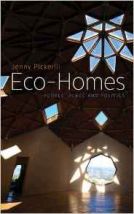Eco-Homes: People, Place and Politics

Written by a builder and occupant of her own eco-home, Sheffield Professor Jenny Pickerill brings us Eco-Homes – a book that unpicks the complexities of social, geographical, and political issues surrounding eco-homes, and that thus helps us to understand much of the resistance to building them. She asserts, “the knowledge, capacity and technology are already available to build eco-homes or retrofit existing housing stock”, but an over-emphasis on technology at the cost of social and aesthetic elements hinders their growth (page 2). This book therefore facilitates dialogue about the need to incorporate social, geographical and political dimensions into the design, planning, construction and occupancy of eco-homes in order to encourage more to be built (page 15).
Eco-Homes draws upon case studies of 34 eco-homes or eco-communities in seven countries: England, Wales, Scotland, Argentina, Thailand, Spain and the United States. In particular, Pickerill attends to eco-housing that has been self-built (although she acknowledges that the meaning of this varies between countries); she argues that this best illustrates that eco-homes can be built cheaply, and self-builders can justify choices as well as identify problems encountered (page 6). Most of Pickerill’s empirical material was collected in 2010 and follows a participatory action research approach as well as a meso-level approach to allow households to be analysed within their broader political, economic and cultural context. Supporting a total of 35 interviews are photographs, observations, sketches and archival material.
To unpick the complexities and resistance around eco-homes, Pickerill uses a social, political and geographical lens to analyse 10 key themes. These themes form the main content of the book, and, informed by the case studies, are addressed by a chapter each. These are: Eco (Chapter 1); Home (Chapter 2); History (Chapter 3); Place (Chapter 4); Affordability (Chapter 5); Comfort (Chapter 6); Gender (Chapter 7); Mobilisation (Chapter 8); Community (Chapter 9); and Future (Chapter 10).
After Chapter 1 details exactly what an eco-home is, Chapter 2 provides a conceptual discussion on the multi-dimensional nature of home. In Chapter 3, Pickerill traces the historical paths of her case studies through four trajectories: vernacular, community, deep-green and modernist. Chapter 4 explores the concept of place and identifies five ways it is commonly understood in the case studies. Chapter 5 examines how to build affordable eco-homes and therefore unpacks what factors currently push prices up. Through the exploration of bathing practices in three case studies, Pickerill investigates the tension between comfort and sustainable living in eco-homes in Chapter 6. Chapter 7 illustrates gender divisions in building eco-homes and proposes three spaces of opportunity to improve gender relations in eco-communities. Framed by the concept of mobilization, Chapter 8 looks at the movement of knowledge and practice surrounding eco-homes, while Chapter 9 considers the influence that (eco-) communities have upon the building of eco-homes. To conclude and to consider the future of eco-homes, Chapter 10 highlights Pickerill’s key findings, contributions to academia and unresolved issues. It also sets forth eight productive ways forward.
Pickerill’s analysis of eco-homes not only uses concepts from sociological and geographical theories to better understand “the people, place and politics of eco-homes” (page 269). In doing so it also identifies pathways to resolve current challenges and stretches out a hand to bring others – perhaps not yet convinced by eco-homes – on board, noting that eco-homes are diverse in form, and thus more within our grasp than many of us believe. Written for both an academic and practitioner audience, this book is relevant to all interested or practising in the field of eco-housing, be it through construction, planning and policymaking, or academic study.
Book note prepared by Hannah Keren Lee
Search the Book notes database
Our Book notes database contains details and summaries of all the publications included in Book notes since 1993 - with details on how to obtain/download.
Use the search form above, or visit the Book notes landing page for more options and latest content.
For a searchable database for papers in Environment and Urbanization, go to http://eau.sagepub.com/

